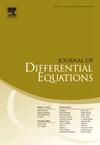Threshold convergence to steady states for nonlocal reaction-diffusion equations with time delay in bounded domain
IF 2.4
2区 数学
Q1 MATHEMATICS
引用次数: 0
Abstract
In this paper, we aim at studying the asymptotic behavior for the time-delayed nonlocal reaction-diffusion equation for population dynamics with Dirichlet boundary condition in . We recognize that there are threshold convergence results of the solutions which depend on the ecological parameters: the spatial diffusion coefficient , the death rate coefficient , the birth rate coefficient , and two principal eigenvalues () of the linear nonlocal dispersion operators induced by the two different kernels with Dirichlet boundaries, respectively. Precisely, when , we prove that the solution globally converges to the trivial steady state 0 at the exponential rate. When , we further prove that the solution globally converges to the non-trivial steady state at the exponential rate, and yet this convergence locally holds if . The convergence rates are also time-exponential. The proof is based on the Fourier transform and the energy method involving the eigenvalue problems for nonlocal dispersion equations. Some new techniques and skills for treating the nonlocality and non-monotonicity with restriction in bounded domain are also proposed. Finally, a number of numerical simulations are carried out, which confirm our theoretical results. For , the solutions are numerically tested to be oscillating.
有界域上具有时滞的非局部反应扩散方程的阈值收敛
在本文中,我们的目的是研究具有Dirichlet边界条件的种群动力学时滞非局部反应扩散方程在Ω∧RN中的渐近行为。我们认识到,解的阈值收敛结果依赖于生态参数:空间扩散系数D>;0,死亡率系数δ>;0,出生率系数p>;0和两个主特征值0<;λi<1 (i=1,2),分别由两个不同的Dirichlet边界核引起的线性非局部色散算子。精确地说,当0<;(1−λ2)pDλ1+δ<;1时,我们证明了解以指数速率全局收敛于平凡稳态0。当1<;(1−λ2)pDλ1+δ≤e时,我们进一步证明了解以指数速率全局收敛于非平凡稳态φ (x),而当e<;(1−λ2)pDλ1+δ<;e2时,这种收敛性局部成立。收敛速度也是时间指数的。基于傅里叶变换和涉及非局部色散方程特征值问题的能量法进行了证明。提出了一些处理有界域非局域性和限制非单调性的新方法和技巧。最后进行了数值模拟,验证了理论结果。对于(1−λ2)pDλ1+δ>e2,数值测试了该解的振荡性。
本文章由计算机程序翻译,如有差异,请以英文原文为准。
求助全文
约1分钟内获得全文
求助全文
来源期刊
CiteScore
4.40
自引率
8.30%
发文量
543
审稿时长
9 months
期刊介绍:
The Journal of Differential Equations is concerned with the theory and the application of differential equations. The articles published are addressed not only to mathematicians but also to those engineers, physicists, and other scientists for whom differential equations are valuable research tools.
Research Areas Include:
• Mathematical control theory
• Ordinary differential equations
• Partial differential equations
• Stochastic differential equations
• Topological dynamics
• Related topics

 求助内容:
求助内容: 应助结果提醒方式:
应助结果提醒方式:


